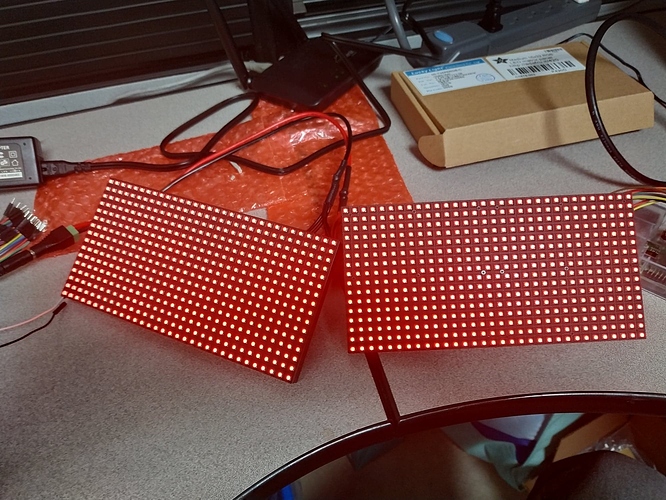Bonjour à tous,
Je suis complètement novice dans l’utilisation de raspberry. J’ai un projet impliquant l’utilisation de deux LED panels (16x32). Dans mon projet final, les deux panels seront allumés en fonction de la détection d’un individu grâce à une caméra. Mais ceci est pour plus tard, j’essaie d’abord de me familiariser avec les LED panels.
J’ai donc à ma disposition:
Une raspberry 3B
deux LED panels Adafruit (Medium 16x32 RGB LED Matrix Panel)
J’ai suivi ce tuto pour tout ce qui était branchement et code : Overview | Connecting a 16x32 RGB LED Matrix Panel to a Raspberry Pi | Adafruit Learning System
J’utilise plus particulièrement le code python fournit dans ce tuto :
import RPi.GPIO as GPIO
import time
delay = 0.000001
GPIO.setmode(GPIO.BCM)
red1_pin = 17
green1_pin = 18
blue1_pin = 22
red2_pin = 23
green2_pin = 24
blue2_pin = 25
clock_pin = 3
a_pin = 7
b_pin = 8
c_pin = 9
latch_pin = 4
oe_pin = 2
GPIO.setup(red1_pin, GPIO.OUT)
GPIO.setup(green1_pin, GPIO.OUT)
GPIO.setup(blue1_pin, GPIO.OUT)
GPIO.setup(red2_pin, GPIO.OUT)
GPIO.setup(green2_pin, GPIO.OUT)
GPIO.setup(blue2_pin, GPIO.OUT)
GPIO.setup(clock_pin, GPIO.OUT)
GPIO.setup(a_pin, GPIO.OUT)
GPIO.setup(b_pin, GPIO.OUT)
GPIO.setup(c_pin, GPIO.OUT)
GPIO.setup(latch_pin, GPIO.OUT)
GPIO.setup(oe_pin, GPIO.OUT)
screen = [[0 for x in xrange(32)] for x in xrange(16)]
def clock():
GPIO.output(clock_pin, 1)
GPIO.output(clock_pin, 0)
def latch():
GPIO.output(latch_pin, 1)
GPIO.output(latch_pin, 0)
def bits_from_int(x):
a_bit = x & 1
b_bit = x & 2
c_bit = x & 4
return (a_bit, b_bit, c_bit)
def set_row(row):
#time.sleep(delay)
a_bit, b_bit, c_bit = bits_from_int(row)
GPIO.output(a_pin, a_bit)
GPIO.output(b_pin, b_bit)
GPIO.output(c_pin, c_bit)
#time.sleep(delay)
def set_color_top(color):
#time.sleep(delay)
red, green, blue = bits_from_int(color)
GPIO.output(red1_pin, red)
GPIO.output(green1_pin, green)
GPIO.output(blue1_pin, blue)
#time.sleep(delay)
def set_color_bottom(color):
#time.sleep(delay)
red, green, blue = bits_from_int(color)
GPIO.output(red2_pin, red)
GPIO.output(green2_pin, green)
GPIO.output(blue2_pin, blue)
#time.sleep(delay)
def refresh():
for row in range(8):
GPIO.output(oe_pin, 1)
set_color_top(0)
set_row(row)
#time.sleep(delay)
for col in range(32):
set_color_top(screen[row][col])
set_color_bottom(screen[row+8][col])
clock()
#GPIO.output(oe_pin, 0)
latch()
GPIO.output(oe_pin, 0)
time.sleep(delay)
def fill_rectangle(x1, y1, x2, y2, color):
for x in range(x1, x2):
for y in range(y1, y2):
screen[y][x] = color
def set_pixel(x, y, color):
screen[y][x] = color
fill_rectangle(0, 0, 12, 12, 1)
fill_rectangle(20, 4, 30, 15, 2)
fill_rectangle(15, 0, 19, 7, 7)
while True:
refresh()
Ce code fonctionne très bien avec un seul led panel, mais lorsque je chaîne mon deuxième écran avec le premier, quoi que je change, la même chose s’affiche sur les deux pannels (comme sur la photo).
J’aimerais pouvoir par exemple avoir un écran vert et un écran rouge. Comment puis-je modifier le code ou les branchements afin d’obtenir ce résultat?
Merci d’avance pour vos réponse.
Cordialement.
